β-Cyclodextrin/Thymol Microcapsule-Embedded Starch Coatings for Synchronized Antimicrobial Release and Shelf-Life Extension in Blueberries
Abstract
1. Introduction
2. Materials and Methods
2.1. Materials
2.2. Preparation of THY@β-CD Microcapsules
2.3. Encapsulation Efficiency Measurement
2.4. Characterization of THY@β-CD Microcapsules
2.5. Release Behavior of THY@β-CD Microcapsules
2.6. Preparation of Composite Coatings
2.7. Characterization of Composite Coatings
2.7.1. Scanning Electron Microscopy (SEM)
2.7.2. Fourier Transform Infrared Spectroscopy
2.7.3. Stereomicroscopic Characterization of Composite Coatings
2.7.4. Determination of Hygroscopicity of Composite Coatings
2.7.5. Wettability of Composite Coatings
2.7.6. Determination of the Viscosity of Composite Coatings
2.8. Determination of the Antimicrobial Performance of Composite Coatings
2.9. Postharvest Treatment of Blueberries with Composite Coatings
2.10. Characterization of Storage Quality of Post-Harvest Blueberries
2.10.1. Sensory Evaluation
2.10.2. Determination of Fruit Peel Appearance and Color Difference
2.10.3. Determination of Fruit Hardness
2.10.4. Determination of Fruit Decay Rate
2.10.5. Determination of Fruit Weight Loss Rate
2.10.6. Anthocyanin Content Determination
2.11. Statistical Analysis
3. Results and Discussions
3.1. The Embedding Rate, Particle Size, Zeta and PDI of THY@β-CD Microcapsules Prepared with Different Wall Core Ratio
3.2. Physicochemical Properties of THY@β-CD Microcapsules
3.3. Determination of the Sustained-Release Properties of THY@β-CD Microcapsules
3.4. Antibacterial Properties of the Composite Coating
3.5. THY@β-CD/PO Composite Coating Characterization
3.6. Preservation Effects of THY@β-CD/PO Composite Coatings on Blueberries During Storage
4. Conclusions
Supplementary Materials
Author Contributions
Funding
Institutional Review Board Statement
Informed Consent Statement
Data Availability Statement
Conflicts of Interest
References
- Mustafa, A.M.; Angeloni, S.; Abouelenein, D.; Acquaticci, L.; Xiao, J.; Sagratini, G.; Maggi, F.; Vittori, S.; Caprioli, G. A new HPLC-MS/MS method for the simultaneous determination of 36 polyphenols in blueberry, strawberry and their commercial products and determination of antioxidant activity. Food Chem. 2022, 367, 130743. [Google Scholar] [CrossRef]
- Su, X.; Zhang, J.; Wang, H.; Xu, J.; He, J.; Liu, L.; Zhang, T.; Chen, R.; Kang, J. Phenolic acid profiling, antioxidant, and anti-inflammatory activities, and miRNA regulation in the polyphenols of 16 blueberry samples from China. Molecules 2017, 22, 312. [Google Scholar] [CrossRef]
- Chu, W.; Gao, H.; Chen, H.; Fang, X.; Zheng, Y. Effects of cuticular wax on the postharvest quality of blueberry fruit. Food Chem. 2018, 239, 68–74. [Google Scholar] [CrossRef] [PubMed]
- Zhang, R.; Wang, X.; Cheng, M. Preparation and characterization of potato starch film with various size of nano-SiO2. Polymers 2018, 10, 1172. [Google Scholar] [CrossRef]
- Wang, L.; Jin, P.; Wang, J.; Gong, H.; Zhang, S.; Zheng, Y. Hot air treatment induces resistance against blue mold decay caused by Penicillium expansum in sweet cherry (Prunus cerasus L.) fruit. Sci. Hortic. 2015, 189, 74–80. [Google Scholar] [CrossRef]
- Li, T.; Yamane, H.; Tao, R. Preharvest long-term exposure to UV-B radiation promotes fruit ripening and modifies stage-specific anthocyanin metabolism in highbush blueberry. Hortic. Res. 2021, 8, 67. [Google Scholar] [CrossRef]
- Hussain, P.; Rather, S.; Suradkar, P.; Parveen, S.; Mir, M.; Shafi, F. Potential of carboxymethyl cellulose coating and low dose gamma irradiation to maintain storage quality, inhibit fungal growth and extend shelf-life of cherry fruit. J. Food Sci. Technol. 2016, 53, 2966–2986. [Google Scholar] [CrossRef]
- Jaramillo Sanchez, G.; Contigiani, E.V.; Bernarda Coronel, M.; Alzamora, S.M.; Garcia-Loredo, A.; Nieto, A.B. Study of UV-C treatments on postharvest life of blueberries ‘O’Neal’ and correlation between structure and quality parameters. Heliyon 2021, 7, e07190. [Google Scholar] [CrossRef]
- Janisiewicz, W.J.; Conway, W.S. Combining biological control with physical and chemical treatments to control fruit decay after harvest. Stewart Postharvest Rev. 2010, 6, 3. [Google Scholar] [CrossRef][Green Version]
- El Khetabi, A.; Lahlali, R.; Ezrari, S.; Radouane, N.; Lyousfi, N.; Banani, H.; Askarne, L.; Tahiri, A.; El Ghadraoui, L.; Belmalha, S.; et al. Role of plant extracts and essential oils in fighting against postharvest fruit pathogens and extending fruit shelf life: A review. Trends Food Sci. Technol. 2022, 120, 402–417. [Google Scholar] [CrossRef]
- Liu, C.; Ding, J.; Deng, S.; Qin, W.; Liu, Y. Isolation and identification of pathogenic fungi from postharvest blueberry in Sichuan province and the inhibition effect on them by using essential oil. Food Mach. 2022, 38, 134–140. [Google Scholar]
- He, J.; Peng, Q.; Wang, J.; Deng, J.; Li, W.; Lin, Q.; Zhong, F.; Xia, X. An intelligent thymol/alizarin-loaded polycaprolactone/gelatin/zein nanofibrous film with pH-responsive and antibacterial properties for shrimp freshness monitoring and preservation. Food Chem. 2025, 471, 142812. [Google Scholar] [CrossRef]
- Lian, H.; Wei, W.; Wang, D.; Jia, L.; Yang, X. Effect of thymol on physical properties, antimicrobial properties and fresh-keeping application of cherry tomato of starch/PBAT extrusion blowing films. Food Sci. Technol. 2022, 42, e43922. [Google Scholar] [CrossRef]
- Saki, M.; ValizadehKaji, B.; Abbasifar, A.; Shahrjerdi, I. Effect of chitosan coating combined with thymol essential oil on physicochemical and qualitative properties of fresh fig (Ficus carica L.) fruit during cold storage. J. Food Meas. Charact. 2019, 13, 1147–1158. [Google Scholar] [CrossRef]
- Zhou, W.; Zhang, Y.; Li, R.; Peng, S.; Ruan, R.; Li, J.; Liu, W. Fabrication of caseinate stabilized thymol nanosuspensions via the pH-driven method: Enhancement in water solubility of thymol. Foods 2021, 10, 1074. [Google Scholar] [CrossRef]
- Li, Q.; Li, X.; Zhao, C. Strategies to obtain encapsulation and controlled release of small hydrophilic molecules. Front. Bioeng. Biotechnol. 2020, 8, 437. [Google Scholar] [CrossRef]
- Alizadeh, N.; Nazari, F. Thymol essential oil/β-cyclodextrin inclusion complex into chitosan nanoparticles: Improvement of thymol properties in vitro studies. J. Mol. Liq. 2022, 346, 118250. [Google Scholar] [CrossRef]
- Lin, L.; Zhu, Y.; Thangaraj, B.; Abdel-Samie, M.A.; Cui, H. Improving the stability of thyme essential oil solid liposome by using β-cyclodextrin as a cryoprotectant. Carbohydr. Polym. 2018, 188, 243–251. [Google Scholar] [CrossRef] [PubMed]
- Sahu, K.M.; Patra, S.; Swain, S.K. Host-guest drug delivery by β-cyclodextrin assisted polysaccharide vehicles: A review. Int. J. Biol. Macromol. 2023, 240, 124338. [Google Scholar] [CrossRef] [PubMed]
- Zou, Y.; Yuan, C.; Cui, B.; Sha, H.; Liu, P.; Lu, L.; Wu, Z. High-amylose corn starch/konjac glucomannan composite film: Reinforced by incorporating β-cyclodextrin. J. Agric. Food Chem. 2021, 69, 2493–2500. [Google Scholar] [CrossRef]
- Jimenez, A.; Fabra, M.J.; Talens, P.; Chiralt, A. Edible and biodegradable starch films: A review. Food Bioprocess Technol. 2012, 5, 2058–2076. [Google Scholar] [CrossRef]
- Zhang, X.; Ou, R.; Fan, Y.; Lian, H.; Li, Y.; Wang, X. Quality changes of rabbiteye blueberry by different cooling treatmet for storage and transportation. J. Hunan Agric. Univ. (Nat. Sci.) 2018, 44, 171–175. [Google Scholar]
- Syafiq, R.; Sapuan, S.; Zuhri, M.; Ilyas, R.; Nazrin, A.; Sherwani, S.; Khalina, A. Antimicrobial activities of starch-based biopolymers and biocomposites incorporated with plant essential oils: A review. Polymers 2020, 12, 2403. [Google Scholar] [CrossRef]
- NY/T 3033-2016; Soil Conditioner—General Requirements. Ministry of Agriculture and Rural Affairs of the People‘s Republic of China: Beijing, China, 2016.
- Hill, L.E.; Gomes, C.; Taylor, T.M. Characterization of beta-cyclodextrin inclusion complexes containing essential oils (trans-cinnamaldehyde, eugenol, cinnamon bark, and clove bud extracts) for antimicrobial delivery applications. LWT-Food Sci. Technol. 2013, 51, 86–93. [Google Scholar] [CrossRef]
- Luo, Y.; Li, M.; Zhu, K.-X.; Guo, X.-N.; Peng, W.; Zhou, H.-M. Heat-induced interaction between egg white protein and wheat gluten. Food Chem. 2016, 197, 699–708. [Google Scholar] [CrossRef]
- Zhao, S.; Jia, R.; Yang, J.; Dai, L.; Ji, N.; Xiong, L.; Sun, Q. Development of chitosan/tannic acid/corn starch multifunctional bilayer smart films as pH-responsive actuators and for fruit preservation. Int. J. Biol. Macromol. 2022, 205, 419–429. [Google Scholar] [CrossRef] [PubMed]
- Zhao, L.; Liu, W.; Wang, H. General Guidance and Method for Establishing Index System of Food Sensory Evaluation. J. Chin. Inst. Food Sci. Technol. 2008, 8, 121–124. [Google Scholar]
- Jia, Y.; Hu, Z. Study on Anthocyanins Stability in Blueberry Beverage. J. Nucl. Agric. Sci. 2016, 30, 941–948. [Google Scholar]
- Su, S.; Li, Q.; Xiong, J. Optimizing Technology of Stirred Buffalo Milk Yogurt with Mango. Mod. Food Sci. Technol. 2012, 28, 319–322. [Google Scholar]
- Jiang, X.; Ding, J.; Chu, X.; Zhao, Y.; Chen, M.; Yan, J.; Dai, J.; Qin, W.; Liu, Y. Effects of H. uvarum combined with KGM on postharvest diseases of blueberry. Food Biosci. 2023, 53, 102730. [Google Scholar] [CrossRef]
- De Queiroz, J.L.C.; Costa, R.O.D.A.; Matias, L.L.R.; De Medeiros, A.F.; Gomes, A.F.T.; Pais, T.D.S.; Passos, T.S.; Maciel, B.L.L.; Dos Santos, E.A.; Morais, A.H.D.A. Chitosan-whey protein nanoparticles improve encapsulation efficiency and stability of a trypsin inhibitor isolated from Tamarindus indica L. Food Hydrocoll. 2018, 84, 247–256. [Google Scholar] [CrossRef]
- Anaya-Castro, M.A.; Ayala-Zavala, J.F.; Muñoz-Castellanos, L.; Hernández-Ochoa, L.; Peydecastaing, J.; Durrieu, V. β-Cyclodextrin inclusion complexes containing clove (Eugenia caryophyllata) and Mexican oregano (Lippia berlandieri) essential oils: Preparation, physicochemical and antimicrobial characterization. Food Packag. Shelf Life 2017, 14, 96–101. [Google Scholar] [CrossRef]
- Mohseni, M.; Mousavi, M.; Kiani, H.; Homayoonfal, M.; Khademi, A. Enhancing the bioaccessibility of L-Citrulline using chitosan-coated nanoliposomes: Physicochemical properties and release kinetics in simulated gastrointestinal conditions. J. Agric. Food Res. 2025, 19, 101630. [Google Scholar] [CrossRef]
- Hu, J.; Wang, L.; Song, Z.; Zhou, M.; Lai, M.; Cui, B.; Xiao, M.; Yang, J.; Wu, C.; Zhao, M. Preparation and properties of thermal responsive 2, 3-diethyl-5-methylpyrazine fragrance microcapsules with β-CD/CS as wall materials. Int. J. Biol. Macromol. 2024, 283, 13785. [Google Scholar] [CrossRef]
- Kiasat, A.R.; Saghanezhad, S.J.; Noori, S. β-Cyclodextrin based nanosponges in organic synthesis. Curr. Org. Chem. 2019, 23, 2366–2377. [Google Scholar] [CrossRef]
- Niu, H.; Chen, W.; Chen, W.; Yun, Y.; Zhong, Q.; Fu, X.; Chen, H.; Liu, G. Preparation and characterization of a modified-β-cyclodextrin/β-carotene inclusion complex and its application in pickering emulsions. J. Agric. Food Chem. 2019, 67, 12875–12884. [Google Scholar] [CrossRef]
- Li, Z.; Sun, Y.; Pan, X.; Gao, T.; He, T.; Chen, C.; Zhang, B.; Fu, X.; Huang, Q. Controlled release of thymol by cyclodextrin metal-organic frameworks for preservation of cherry tomatoes. Foods 2022, 11, 3818. [Google Scholar] [CrossRef] [PubMed]
- Dorofte, A.L.; Dima, C.; Bleoanca, I.; Aprodu, I.; Alexe, P.; Kharazmi, M.S.; Jafari, S.M.; Dima, Ș.; Borda, D. Mechanism of β–cyclodextrin-thyme nanocomplex formation and release: In silico behavior, structural and functional properties. Carbohydr. Polym. Technol. Appl. 2024, 7, 100422. [Google Scholar] [CrossRef]
- Jiang, L.; Yang, J.; Wang, Q.; Ren, L.; Zhou, J. Physicochemical properties of catechin/β-cyclodextrin inclusion complex obtained via co-precipitation. J. Food 2019, 17, 544–551. [Google Scholar] [CrossRef]
- Su, Y.; Dang, J.; Zhang, H.; Zhang, Y.; Tian, W. Supramolecular Host–Guest Interaction-Enhanced Adjustable Drug Release Based on β-Cyclodextrin-Functionalized Thermoresponsive Porous Polymer Films. Langmuir 2017, 33, 7393–7402. [Google Scholar] [CrossRef] [PubMed]
- Portet, S. A primer on model selection using the Akaike Information Criterion. Infect. Dis. Model. 2020, 5, 111–128. [Google Scholar] [CrossRef]
- Schubert, A.-L.; Hagemann, D.; Voss, A.; Bergmann, K. Evaluating the model fit of diffusion models with the root mean square error of approximation. J. Math. Psychol. 2017, 77, 29–45. [Google Scholar] [CrossRef]
- Liu, Y.; Pan, L.; Li, T.; Tang, T.; Xu, R.; Duan, X.; Rasheed, Z.; Chen, M.; Tang, W.; Yan, J.; et al. Improving the performance of kraft paper by cinnamon essential oil/soybean protein isolate microcapsules and konjac glucomannan for citrus preservation. Int. J. Biol. Macromol. 2024, 277, 134308. [Google Scholar] [CrossRef] [PubMed]
- Qiang, Y.; Wei, H.; Huang, B.; Chi, H.; Fu, J. Inclusion complex of turmeric essential oil with hydroxypropyl-β-cyclodextrin: Preparation, characterization and release kinetics. Curr. Res. Food Sci. 2024, 8, 100668. [Google Scholar] [CrossRef]
- Saidi, M.; Dabbaghi, A.; Rahmani, S. Swelling and drug delivery kinetics of click-synthesized hydrogels based on various combinations of PEG and star-shaped PCL: Influence of network parameters on swelling and release behavior. Polym. Bull. 2020, 77, 3989–4010. [Google Scholar] [CrossRef]
- Zhao, Y.; Wang, Y.; Zhang, Z.; Li, H. Advances in controllable release essential oil microcapsules and their promising applications. Molecules 2023, 28, 4979. [Google Scholar] [CrossRef]
- Beristain-Bauza, S.; Mani-López, E.; Palou, E.; López-Malo, A. Antimicrobial activity and physical properties of protein films added with cell-free supernatant of Lactobacillus rhamnosus. Food Control 2016, 62, 44–51. [Google Scholar] [CrossRef]
- Ryu, S.-R.; Noda, I.; Jung, Y.-M. Relationship between infrared peak maximum position and molecular interactions. Bull. Korean Chem. Soc. 2011, 32, 4011–4015. [Google Scholar] [CrossRef]
- Ge, Z.; Liu, L.; Wang, N.; Wei, L. Research on printing performance of full potato powder: The relationship between rheological properties, microstructure, and printing performance. J. Food Process Eng. 2024, 47, e14502. [Google Scholar]
- Yen, T.-H.; Soong, C.-Y. Hybrid Cassie-Wenzel model for droplets on surfaces with nanoscale roughness. Phys. Rev. E 2016, 93, 022805. [Google Scholar] [CrossRef]
- Shi, C.; Zhou, A.; Fang, D.; Lu, T.; Wang, J.; Song, Y.; Lyu, L.; Wu, W.; Huang, C.; Li, W. Oregano essential oil/β-cyclodextrin inclusion compound polylactic acid/polycaprolactone electrospun nanofibers for active food packaging. Chem. Eng. J. 2022, 445, 136746. [Google Scholar] [CrossRef]
- Fu, H.; Huang, R.; Li, J.; Lin, Z.; Wei, F.; Lin, B. Multifunctional cinnamaldehyde-tannic acid nano-emulsion/chitosan composite film for mushroom preservation. Food Hydrocoll. 2023, 145, 109111. [Google Scholar] [CrossRef]
- Tabassum, N.; Khan, M.A. Modified atmosphere packaging of fresh-cut papaya using alginate based edible coating: Quality evaluation and shelf life study. Sci. Hortic. 2020, 259, 108853. [Google Scholar] [CrossRef]
- Khan, M.R.; Di Giuseppe, F.A.; Torrieri, E.; Sadiq, M.B. Recent advances in biopolymeric antioxidant films and coatings for preservation of nutritional quality of minimally processed fruits and vegetables. Food Packag. Shelf Life 2021, 30, 100752. [Google Scholar] [CrossRef]
- Cui, H.; Cheng, Q.; Li, C.; Khin, M.N.; Lin, L. Schiff base cross-linked dialdehyde β-cyclodextrin/gelatin-carrageenan active packaging film for the application of carvacrol on ready-to-eat foods. Food Hydrocoll. 2023, 141, 108744. [Google Scholar] [CrossRef]
- Ye, S.; Chen, J.; Cao, S.; Luo, D.; Ba, L. Thymol application delays the decline of fruit quality in blueberries via regulation of cell wall, energy and membrane lipid metabolism. Food Chem. 2024, 458, 140193. [Google Scholar] [CrossRef] [PubMed]
- Zhao, Y.-W.; Wang, C.-K.; Huang, X.-Y.; Hu, D.-G. Anthocyanin stability and degradation in plants. Plant Signal. Behav. 2021, 16, 1987767. [Google Scholar] [CrossRef]
- Zhang, T.; Zhang, Q.; Pan, Y.; Che, F.; Wang, Q.; Meng, X.; Rao, J. Changes of polyamines and CBFs expressions of two Hami melon (Cucumis melo L.) cultivars during low temperature storage. Sci. Hortic. 2017, 224, 8–16. [Google Scholar] [CrossRef]

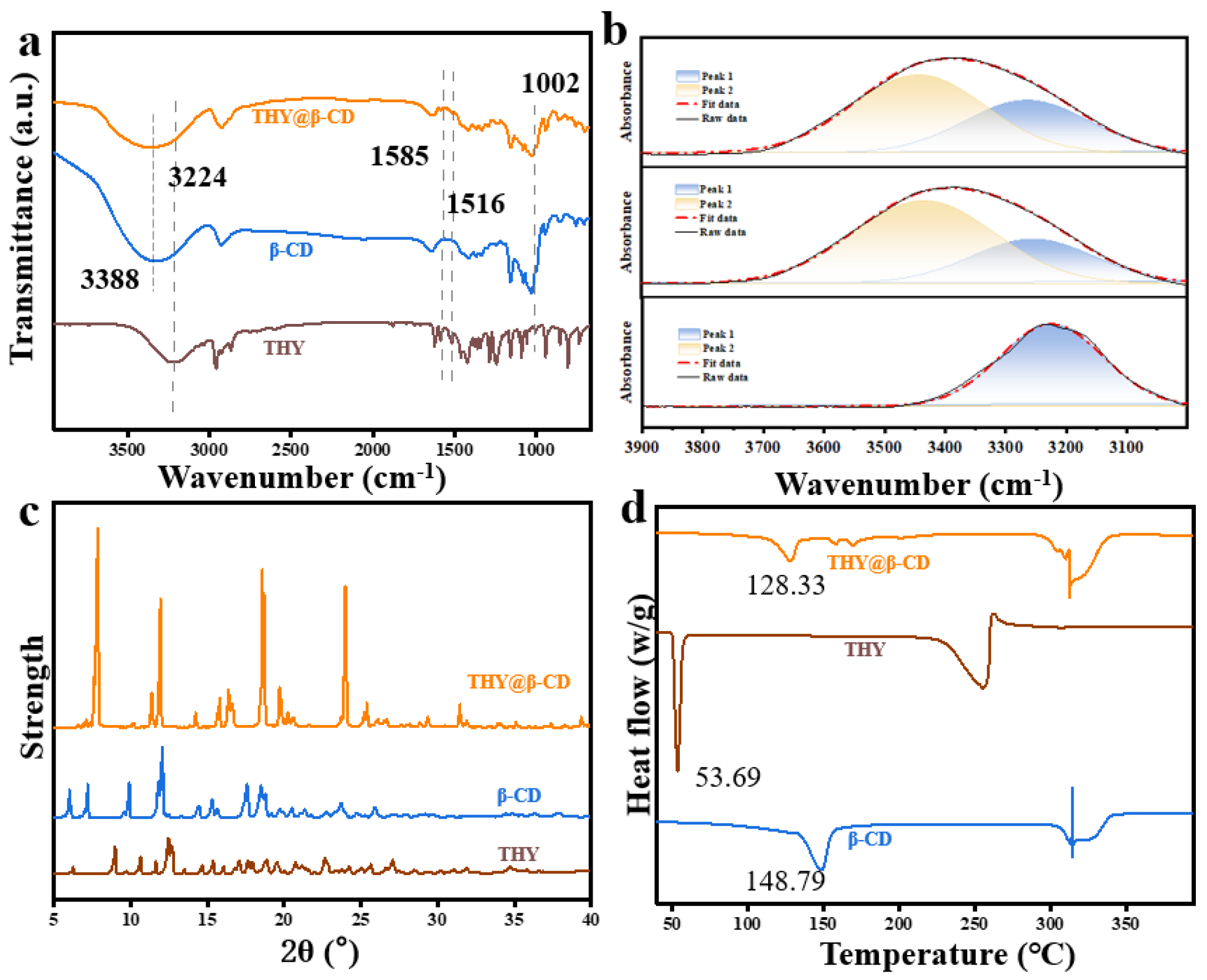
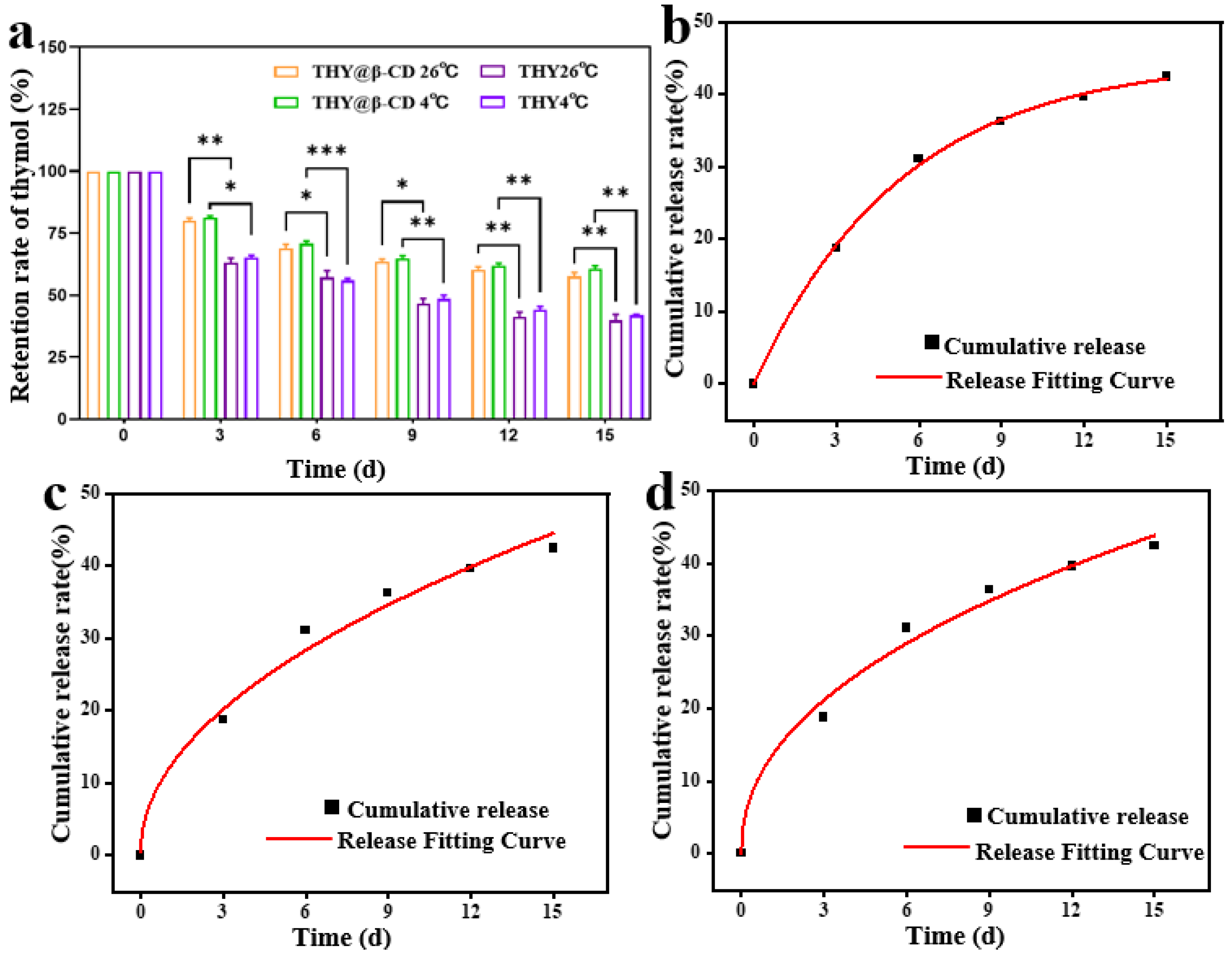

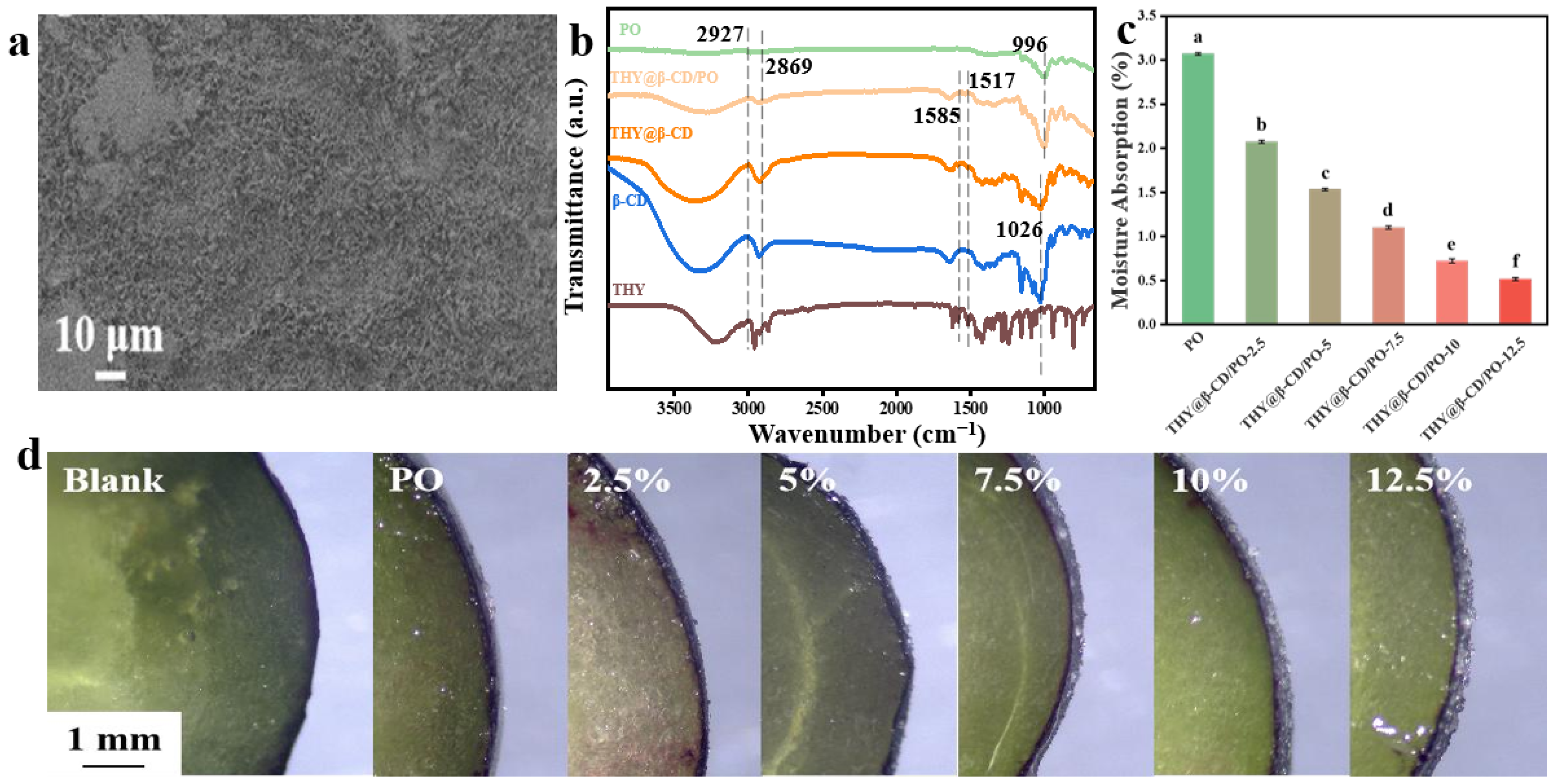
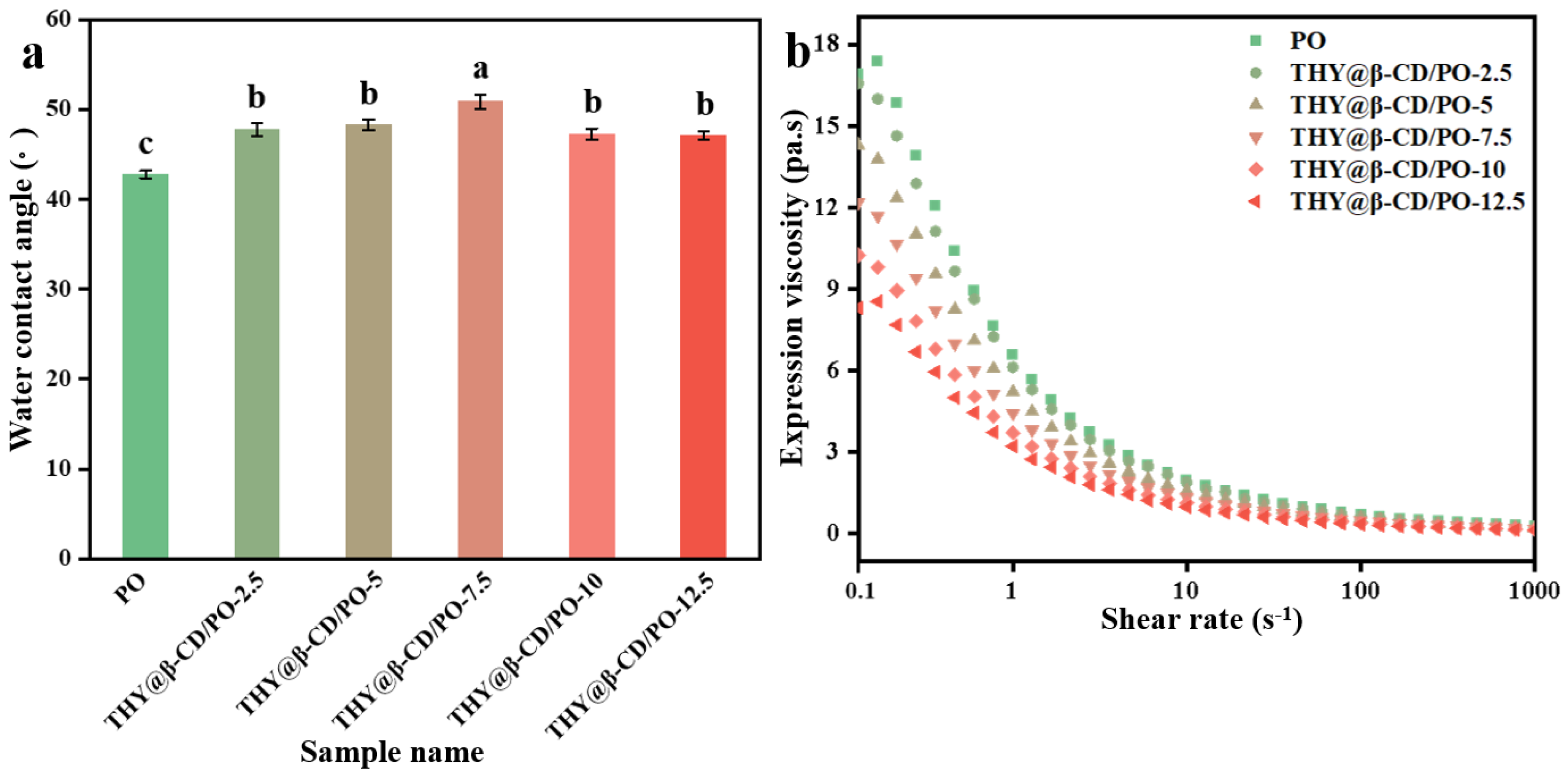


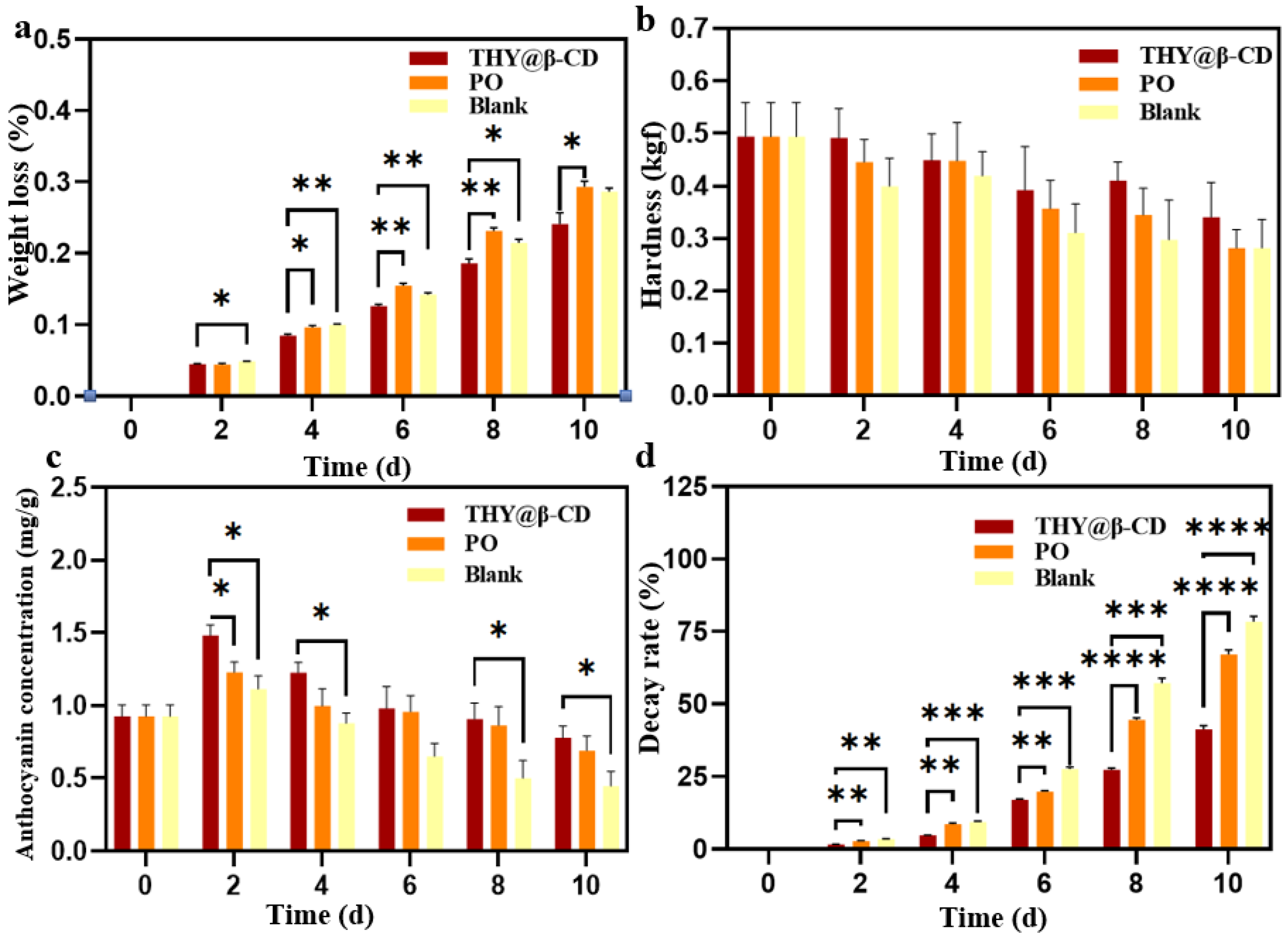
| Model | Formula |
|---|---|
| first-order | Q = k × (1 − ent) |
| Higuchi | Q = k × t0.5 + n |
| Korsemeyer–Peppas | Q = k × tn |
| Score | Flavor and Aroma | Appearance | Flesh Texture |
|---|---|---|---|
| 8–10 | Fruits are aromatic and have no other odor. | Fruit full, glossy and free from spoilage | Fruit firm, whole and elastic |
| 6–8 | Slight THY odor, no other off-flavors | Good shape, no spoilage | Fruit elastic, slightly less so than when picked |
| 4–6 | Strong musk vanillin odor, no other off-flavors | Fruits dull in color with a few scattered spots. | Fruit slightly soft |
| 2–4 | Flavors of wine and muscovado. | Less water loss, with a small amount of rotting | Fruit soft, little cracked |
| 0–2 | Strong THY flavor, musty and fermented, unacceptable gas | Loss of water and crumpling, severe rotting | Fruit soft, sticky texture, unformed |
| Core Wall Ratio (β-CD:THY) | Embedding Rate (%) | Particle Size (nm) | Zeta Potential (mV) | PDI |
|---|---|---|---|---|
| 1:11 | 66.45 ± 1.21 d | 2120.79 ± 32.73 b | −13.75 ± 0.15 a | 0.687 ± 0.021 ab |
| 1:12 | 68.48 ± 0.81 c | 2053.63 ± 29.54 c | −14.32 ± 0.09 b | 0.706 ± 0.035 ab |
| 1:13 | 73.24 ± 0.82 a | 1927.77 ± 25.39 d | −14.42 ± 0.12 c | 0.672 ± 0.028 b |
| 1:14 | 71.47 ± 0.78 b | 2017.62 ± 33.31 c | −15.77 ± 0.1 c | 0.732 ± 0.027 a |
| 1:15 | 66.73 ± 0.65 d | 2184.34 ± 21.13 a | −17.98 ± 0.12 d | 0.685 ± 0.032 ab |
| Model | k | n | R2 | RSS | RMSE | AIC |
|---|---|---|---|---|---|---|
| first-order | 44.89539 | 0.1869 | 0.99877 | 0.83 | 0.37 | −6.76 |
| Higuchi | 11.37336 | 0.45269 | 0.98592 | 6.76 | 1.06 | 12.40 |
| Korsmeyer–Peppas | 12.87733 | 0.45269 | 0.98350 | 7.91 | 1.15 | 13.48 |
Disclaimer/Publisher’s Note: The statements, opinions and data contained in all publications are solely those of the individual author(s) and contributor(s) and not of MDPI and/or the editor(s). MDPI and/or the editor(s) disclaim responsibility for any injury to people or property resulting from any ideas, methods, instructions or products referred to in the content. |
© 2025 by the authors. Licensee MDPI, Basel, Switzerland. This article is an open access article distributed under the terms and conditions of the Creative Commons Attribution (CC BY) license (https://creativecommons.org/licenses/by/4.0/).
Share and Cite
Li, X.; Liu, Y.; Zheng, J.; Zhu, X.; Fang, W.; Lei, S.; Zhuang, W.; Wu, J.; Hao, T.; You, S.; et al. β-Cyclodextrin/Thymol Microcapsule-Embedded Starch Coatings for Synchronized Antimicrobial Release and Shelf-Life Extension in Blueberries. Foods 2025, 14, 3132. https://doi.org/10.3390/foods14173132
Li X, Liu Y, Zheng J, Zhu X, Fang W, Lei S, Zhuang W, Wu J, Hao T, You S, et al. β-Cyclodextrin/Thymol Microcapsule-Embedded Starch Coatings for Synchronized Antimicrobial Release and Shelf-Life Extension in Blueberries. Foods. 2025; 14(17):3132. https://doi.org/10.3390/foods14173132
Chicago/Turabian StyleLi, Xiangyue, Yuxin Liu, Jiayi Zheng, Xiaoyi Zhu, Weirui Fang, Shanshan Lei, Weiran Zhuang, Jing Wu, Tong Hao, Sulin You, and et al. 2025. "β-Cyclodextrin/Thymol Microcapsule-Embedded Starch Coatings for Synchronized Antimicrobial Release and Shelf-Life Extension in Blueberries" Foods 14, no. 17: 3132. https://doi.org/10.3390/foods14173132
APA StyleLi, X., Liu, Y., Zheng, J., Zhu, X., Fang, W., Lei, S., Zhuang, W., Wu, J., Hao, T., You, S., Wei, X., Qin, W., Liu, Y., & Chen, M. (2025). β-Cyclodextrin/Thymol Microcapsule-Embedded Starch Coatings for Synchronized Antimicrobial Release and Shelf-Life Extension in Blueberries. Foods, 14(17), 3132. https://doi.org/10.3390/foods14173132







